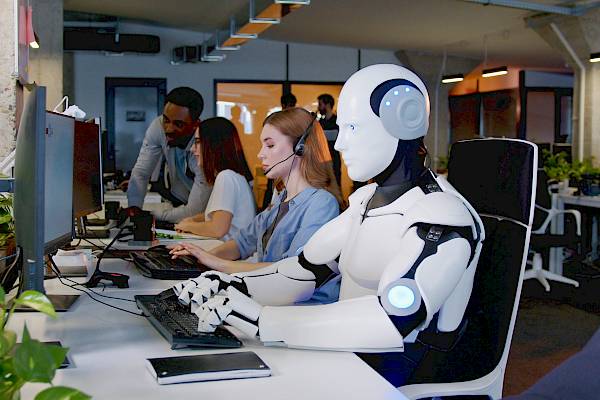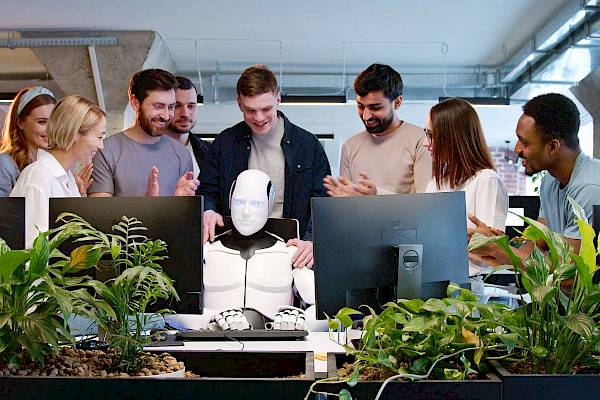In the ever-evolving world of financial services, innovation is key. And it’s now more crucial than ever before. Technology advancements and digital transformations are vital not only to drive a firm's competitive edge but also to help comply with one of the most heavily regulated industries in the UK.
In this edition of Target Tech Bytes, we look at Robotic Process Automation (RPA), finding out what it is and how it can help firms unlock new levels of efficiency and embrace an automated future.
What is RPA?
For someone hearing the term Robotic Process Automation for the first time, you may well envisage robots taking over tasks that humans normally complete. In part, this is correct, however, there’s no physical robots involved as we imagine them to be.
RPA is a technology designed to mimic the way humans interact with software to perform repetitive, high volume and often mundane tasks. The types of tasks that are usually time-consuming, resource-draining, and open to human error. Using a set of predefined rules and logic, RPA automates the tasks or processes that are data driven.
The RPA software scripts, more commonly known as a bot, are developed at a user-interface level to copy keystrokes and mouse clicks to complete a task, as if it were human. Differing from traditional programming, the bots can navigate through existing applications, instead of firms having to invest resource and money on making fundamental changes that enhance systems. The RPA bots can extract data, complete calculations, make decisions based on predefined rules, and produce outputs or trigger actions where required.
A brief history
RPA technology has been catapulted into the limelight in recent years, especially since the pandemic forced businesses to digitally transform. However, the concept emerged in early 2000s, though it has roots in earlier automation efforts which allowed RPA to become what it is today.
The key predecessors of RPA include:
- Screen scraping software
- Workflow automation and management tools
- Artificial intelligence
The first RPA solution was introduced in 2003 by Blue Prism and has since become a mainstream technology. RPA capabilities continue to grow as innovations in technology advance.
The types of RPA
There’re three types of RPA that businesses can implement, lets briefly cover each:
- Assisted automation – Also referred to as attended automation, involves software bots that run on a user’s computer. They’re triggered by specific actions performed by the user at a certain point in the process. Using the bot will speed up the process and frees up the user to concentrate their efforts elsewhere
- Unassisted automation – Also referred to as unattended automation, can work 24/7 and independently without human intervention. These types of RPA bots are usually scheduled to run at specific times or following predefined events and will be designed to notify users if an error occurs
- Hybrid automation – Allows the bot and user to work together, combining assisted and unassisted RPA.
So, is RPA the same as artificial intelligence?
Unlike Artificial Intelligence (AI) which is data-driven, RPA is process driven. RPA bots complete a task by following the predefined processes and rules, whilst AI bots use machine learning to identify patterns in data and learn over time. AI aims to simulate human intelligence, whereas RPA is used to replicate tasks ordinarily carried out by humans.
Hyperautomation
The important thing to note here is that business processes can sometimes be complex, so the use of advanced technologies together is needed to fully automate a process. Effectively combining the use of software technology such as RPA, machine learning, and AI will reap the most reward.
Hyperautomation was a term coined by Gartner in 2019. It’s the coordinated use of multiple technologies including, but not limited to, RPA, AI, Machine Learning and Business Process Management (BPM) to scale automation within a business.
Advantages and disadvantages of using RPA
RPA continues its development curve, rapidly evolving alongside other emerging technologies. Similarly, RPA has its advantages and disadvantages; let’s explore some:
Advantages
- Increased efficiency and productivity leading to cost savings – a key benefit of implementing RPA is the amount of time it would save by allowing the bot to complete the time-consuming, repetitive tasks, freeing up the human resource to more value-adding processes
- Reduces errors and standardises processes – RPA will reduce the risk of errors by working with precision, sticking to a defined process which humans may often deviate from
- Provides enhanced customer experience and improves customer satisfaction – as the RPA bots can complete time-consuming processes much quicker than a user, this will boost customer satisfaction
- Cost-effective – implementing an RPA solution will cost significantly less than overhauling existing legacy systems.
Disadvantages
- Loss of jobs – whilst RPA wouldn’t replace humans in the workplace completely, they will reduce the amount of resource required for roles such as administration
- No human initiative – as the RPA bots work on defined rules, there’s no human initiative to deal with any different scenarios
- Magnify inefficient processes – if no review of processes due to be automated, takes place, RPA may magnify any inefficiencies and create more issues. Effectively becoming a sticking plaster over a deep wound
- Not suitable for non-repetitive tasks – RPA wouldn’t be a one size fits all and wouldn’t be suitable for non-repetitive tasks requiring human decisions. This is where hyperautomation comes in to turn the disadvantage into an advantage.
Who is using RPA?
McKinsey estimates that emerging technologies including advanced robotics and robotic tools could have a global economic impact of between $14 trillion and $33 trillion a year in 2025.
The Covid-19 pandemic gave businesses no choice but to accelerate digital transformation, with employees working remotely and customers needing more support than ever. RPA technology was a perfect way to automate processes and back-end tasks without the complex system changes with attached high price tags.
Gartner projected that the worldwide RPA software spending will reach $3.4 billion in 2023, a 17.5% growth rate compared to 2022, as businesses advance their RPA offerings with embedded hyperautomation capabilities.
Zurich Insurance Group was an early adopter and has realised the benefits of RPA technology since 2016. It improves the services offered throughout the lifetime of an insurance policy, benefitting both their customers and the business.
How can RPA improve your business?
All businesses have those day to day, time consuming data tasks, right? Well, it’s time those tasks no longer drain resource, it’s time for the bots to take over. Whether it’s loan onboarding, finance or customer services processes you’re looking to improve, RPA technology could be the answer.
Our experts here at Target partnered with our parent company, Tech Mahindra who have successfully delivered over 125 RPA implementations, can work with you to identify the benefits RPA can make to your business.
Resources
- https://www.techtarget.com/searchcio/Ultimate-guide-to-RPA-robotic-process-automation
- https://www.theknowledgeacademy.com/blog/advantages-and-disadvantages-of-rpa/
- https://www.ibm.com/topics/rpa
- https://www.mckinsey.com/capabilities/mckinsey-digital/our-insights/disruptive-technologies
- https://www.gartner.com/en/newsroom/press-releases/2022-08-1-rpa-forecast-2022-2q22-press-release
- https://www.zurich.com/en/products-and-services/protect-your-business/commercial-insurance-risk-insights/robotics-take-the-tedium-from-policy-administration-and-give-back-efficiency
- https://www.techmahindra.com/en-in/techmnxt/platform/rpa-uno/




